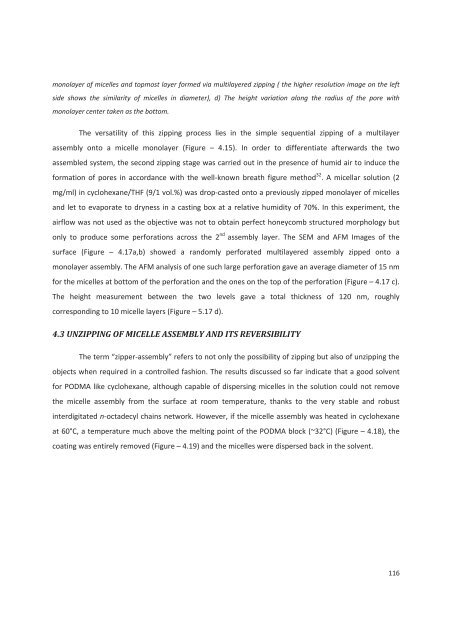4(%3)3 - Ecole nationale supérieure de chimie de Montpellier
4(%3)3 - Ecole nationale supérieure de chimie de Montpellier
4(%3)3 - Ecole nationale supérieure de chimie de Montpellier
Create successful ePaper yourself
Turn your PDF publications into a flip-book with our unique Google optimized e-Paper software.
monolayer of micelles and topmost layer formed via multilayered zipping ( the higher resolution image on the leftsi<strong>de</strong> shows the similarity of micelles in diameter), d) The height variation along the radius of the pore withmonolayer center taken as the bottom.The versatility of this zipping process lies in the simple sequential zipping of a multilayerassembly onto a micelle monolayer (Figure – 4.15). In or<strong>de</strong>r to differentiate afterwards the twoassembled system, the second zipping stage was carried out in the presence of humid air to induce theformation of pores in accordance with the well-known breath figure method 32 . A micellar solution (2mg/ml) in cyclohexane/THF (9/1 vol.%) was drop-casted onto a previously zipped monolayer of micellesand let to evaporate to dryness in a casting box at a relative humidity of 70%. In this experiment, theairflow was not used as the objective was not to obtain perfect honeycomb structured morphology butonly to produce some perforations across the 2 nd assembly layer. The SEM and AFM Images of thesurface (Figure – 4.17a,b) showed a randomly perforated multilayered assembly zipped onto amonolayer assembly. The AFM analysis of one such large perforation gave an average diameter of 15 nmfor the micelles at bottom of the perforation and the ones on the top of the perforation (Figure – 4.17 c).The height measurement between the two levels gave a total thickness of 120 nm, roughlycorresponding to 10 micelle layers (Figure – 5.17 d).4.3 UNZIPPING OF MICELLE ASSEMBLY AND ITS REVERSIBILITYThe term “zipper-assembly” refers to not only the possibility of zipping but also of unzipping theobjects when required in a controlled fashion. The results discussed so far indicate that a good solventfor PODMA like cyclohexane, although capable of dispersing micelles in the solution could not removethe micelle assembly from the surface at room temperature, thanks to the very stable and robustinterdigitated n-octa<strong>de</strong>cyl chains network. However, if the micelle assembly was heated in cyclohexaneat 60°C, a temperature much above the melting point of the PODMA block (~32°C) (Figure – 4.18), thecoating was entirely removed (Figure – 4.19) and the micelles were dispersed back in the solvent.116











